Discovering two planets
Scientists have discovered two planets, revolving around one, potentially conditioned for life. These planets can contain water and heat supplies.
In the upcoming study, scientists said they discovered two planets d and e in the Trappist-1 planetary system, which are two planets capable of "having life" , opening up hope for search .
In 2017, NASA announced their discovery of a 7-planet "similar system" that orbits the white dwarf Trappist-1. This is considered a shocking move because scientists have never discovered so many planets like Earth in just one planetary system, never seen a space where extreme temperatures do not. destroy life like that. located 3.9 light years from Earth.

Simulating the planetary system Trappist-1 with 7 planets denoted by b to h.(Graphics: NASA / JPL-Caltech).
The discovery in 2017 led to the hope that there are many planets with large rocky surfaces like Earth in the Milky Way.
Dr. Amy Barr of the Planetary Science Institute (USA) and colleagues in Hungary built the mathematical model of these seven planets and the structure inside them. They found that 6 out of 7 planets may have water, liquid or ice. In it, a planet may have sea. They also simulate the orbits of planets to calculate their surface temperatures.
"That's one of the motives of this research," Barr told the Guardian. "The planets are also on a very strange, egg-like orbit. Every time the planet orbits the star, it is strained or pressed."
Io, the moon of Jupiter, also suffers from the same pulling-pushing force and creates "tidal heat". Io's surface is split by volcanic eruptions, lava flows, scars and pans. Barr said that the same forces might also exist in the Trappist-1 planetary system.
"The planets have their own internal rubbing, the tensile and squeezing forces create heat inside , " he said.

Image simulating the planet Trappist-1d surface.(Photo: NASA).
The two planets Trappist-1d and Trappist-1e are two "reasonable" temperatures. The planet Trappist-1d has a temperature of about 15 degrees Celsius while the Trappist-1e planet is lower. "The temperature you have is the same as Antarctica, but still reasonable (for life)".
- Discovering 'Earth Stone' has 3 suns at the same time
- Discovering earth-like planets are the hottest planets
- Unknown mystery about planets outside the solar system
- Discover more 18 large planets
- Discover a new planet 13 times larger than Jupiter
- Discovering the planet
- Why are planets spherical, and meteorites?
- The truth after each name of the familiar planets
- Discovering more 'future houses' for humankind
- 8 planets are not true to haunt the scientific world
- Discovering new features of Neptune
- Discover more than 700 planets outside the solar system
 Van Allen's belt and evidence that the Apollo 11 mission to the Moon was myth
Van Allen's belt and evidence that the Apollo 11 mission to the Moon was myth The levels of civilization in the universe (Kardashev scale)
The levels of civilization in the universe (Kardashev scale) Today Mars, the sun and the Earth are aligned
Today Mars, the sun and the Earth are aligned The Amazon owner announced a secret plan to build a space base for thousands of people
The Amazon owner announced a secret plan to build a space base for thousands of people